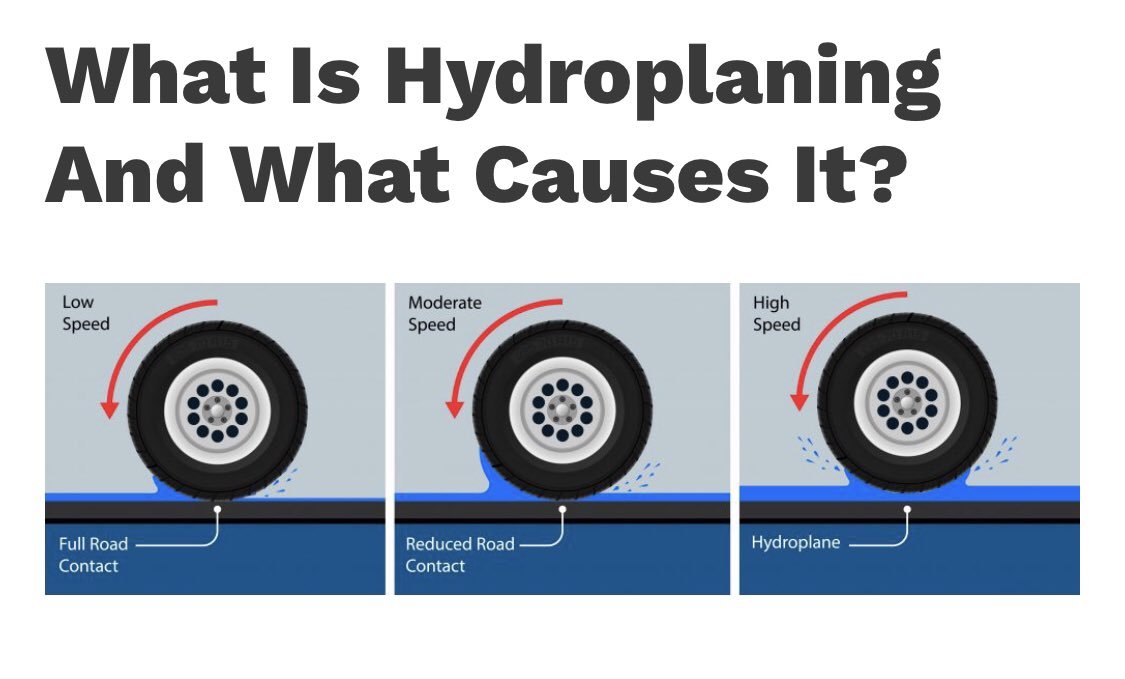What Is Hydroplaning?
In the heart of Atlanta where rain meets asphalt hydroplaning happens. Imagine losing control of your vehicle for a heart-stopping moment when your tires lose contact with the road, floating on a thin sheet of water instead unable to control your car.
The Wilson PC, your trusted Atlanta personal injury law firm, understands the seriousness of these moments. Our mission is to keep you safe on the road, but when accidents happen, we are here to fight for your rights. We want to arm you with every means possible to prevent and react effectively to hydroplaning. In this article, we will walk you through what hydroplaning is, how it happens, and how you can cut down on the risks using simple caution.
How Hydroplaning Happens
To prevent or react correctly to hydroplaning, it's important to understand why and how it occurs. Hydroplaning occurs when a vehicle's tire can't scatter water fast enough to maintain the tire's contact on the road. This forms a thin layer of water between your tire and the road, causing a loss of traction. This loss of traction then leads to the driver's loss of control over steering, braking, and power.
Tire tread plays a critical part in this process. The main function of the treads is to disperse water from beneath the tire to maintain contact with the road. A sufficient tire tread depth, roughly 4/32 to 6/32 inches deep, allows water to escape from underneath the tire, thus preventing hydroplaning.
A uniquely designed tread pattern does not significantly increase resistance against hydroplaning. The depth of your tire tread still remains the most critical factor.
The speeds at which you travel and the amount of water on the road can also influence the likelihood of hydroplaning. Statistics compiled by the National Highway Traffic Safety Administration (NHTSA) show that the likelihood of hydroplaning increases significantly at speeds above 35 mph.
Checking Tire Health to Prevent Hydroplaning
One of the best preventive measures against hydroplaning is ensuring well-maintained tire health, specifically the depth of your tire tread. A tire's tread depth plays an important role in displacing water and maintaining traction with the road surface, especially during heavy rain.
Here are some methods to assess the health of your tire tread:
Using the 'Penny Test'
Insert a penny into your tire's tread groove with Lincoln's head upside down. If you can see all of Lincoln's head, your tire's tread depth is less than 2/32 inches, and it’s time to replace your tires.
Using a Tire Tread Depth Gauge
Consider using a tire tread depth gauge for a more accurate reading of your tire tread depth. These gauges are readily available at most auto parts stores and offer a reliable measurement. To use the gauge, place the probe into the tread groove and read the result. This method is recommended for those who prioritize accuracy and want to make informed decisions about their tire health.
Maintaining adequate tire tread depth is paramount. A tire with tread worn down to the minimum 2/32 inch depth limit, also known as being "bald," has lost a substantial portion of its ability to maintain a proper grip on the road, especially in wet conditions. In rainy weather, the water accumulating on the road can't be effectively channeled away by bald tires, significantly increasing the risk of hydroplaning.
Correcting Tire Inflation
While tread depth is crucial, tire pressure is equally essential when preventing hydroplaning. Underinflated tires can be a recipe for disaster on wet roads. When a tire is underinflated, its tread can't properly contact the road surface. This leads to the tread spreading outward, creating a situation where the tire is more likely to lose traction and glide on the water's surface, causing hydroplaning.
To combat this, it's essential to ensure your tires are inflated to the manufacturer's recommended specifications. Regularly check and maintain your tire pressure within the proper range. This reduces the risk of hydroplaning and promotes even wear across the tire's surface, contributing to overall safety and performance.
Safety Precautions Against Hydroplaning
Mind Your Speed
Driving fast is a big contributor to hydroplaning. As speed increases, the tire gets less time to dispel water, upping the chances of water pressure in front of the wheel pushing water under the tire. Keeping a limit of 35mph or under, especially during or immediately after heavy rainfall should be followed to decrease hydroplaning risks.
Avoid Standing Water
Puddles or areas with standing water significantly heighten the hydroplaning hazard. While sometimes apparent, such regions aren't always clearly visible, especially while driving in the rain or at night. These conditions necessitate extra caution while driving to spot and steer clear of these potential danger zones.
Consider Tire Maintenance
Well-maintained tires play a pivotal role in preventing hydroplaning. The tread depth of your tires directly impacts their ability to disperse water and maintain contact with the road.
Regularly check your tire tread depth using the Penny Test or a Tire Tread Depth Gauge. Aim for a tread depth of 4/32 to 6/32 inches. This ensures effective water evacuation from beneath the tires, reducing the risk of hydroplaning.
Drive Gently
Smooth and controlled driving techniques are crucial in preventing hydroplaning. Abrupt movements can lead to loss of traction and increase the likelihood of hydroplaning.
Practice gradual steering inputs and gentle braking when driving on wet roads. Sudden maneuvers can break the tire's connection with the road, elevating the risk of hydroplaning.
Beware the Cruise Control
While a handy feature for long motorway travel, engaging cruise control during rainfall can heighten the hydroplaning risk. Cruise control does not adapt to road conditions as you would, running the risk of accelerating during hydroplaning, exacerbating the situation.
What to Do If Your Car Hydroplanes
Even with fully-inflated tires, a cautious driving speed, and an eye for standing water, there's still a chance that your vehicle may hydroplane. This is where understanding how to react to hydroplaning becomes life-saving.
Identifying Hydroplaning
Typically, when a vehicle starts hydroplaning, the steering feels light or unresponsive, almost as if the car is floating or sliding. Some drivers may also feel the back end of the car shifting sideways or a sudden decrease in traction.
Stability Control
Modern vehicles come equipped with features such as Electronic Stability Control (ESC) that provide assistance during hydroplane situations. These systems can detect the onset of skidding and take corrective action by applying brakes to individual wheels or reducing engine power.
Right Moves
In the event of hydroplaning, the golden rule is to not panic or make abrupt maneuvers. Do not slam on the brakes—instead, follow these guidelines:
Release the Accelerator: Gradually ease off the accelerator to allow the tires to regain traction with the road. This controlled reduction in speed helps stabilize the vehicle.
Steer Straight and Steady: Keep your steering wheel aligned with the car's direction. Avoid sharp turns or steering corrections, as they can exacerbate skidding.
Gentle Steering Correction: If needed, make subtle and gentle adjustments to the steering wheel in the direction you want your vehicle to follow. Smooth and gradual steering inputs are needed to regain control.
Conclusion
Hitting a patch of water and beginning to hydroplane can be a frightening experience, but with the right knowledge and a cool head, disaster can often be avoided. Recognizing when hydroplaning might occur and taking precautions to avoid or mitigate it can drastically reduce your chance of an accident.
Remember, from checking your tire health regularly and adjusting your driving habits based on the weather to know how to react during a hydroplaning event..
Accidents on the road are oftentimes out of our control, but how we prevent and react to these events is certainly within our control.
FAQ:
1. What is hydroplaning?
Hydroplaning, also known as aquaplaning, is a dangerous driving condition that occurs when a vehicle's tires lose contact with the road surface due to a layer of water, causing the driver to lose control of steering, braking, and power.
2. Why does hydroplaning occur?
Hydroplaning occurs when a vehicle's tires cannot scatter water fast enough to maintain contact with the road. The formation of a water layer between your tires and the road leads to a loss of traction and ultimate loss of vehicle control.
3. How can I prevent hydroplaning?
Preventing hydroplaning largely depends upon maintaining good tire health, specifically tire tread depth. Other preventive measures include driving at a moderate speed, avoiding areas with standing water, keeping an eye on the road conditions, and correcting tire inflation as needed.
4. How can I check the health of my tires?
Tire health can be checked using the 'Penny Test' or a Tire Tread Depth Gauge. You should aim for a tire tread depth of 4/32 to 6/32 inches. Regularly checking and maintaining your tire pressure within the recommended range also contributes to tire health.
5. What should I do if my car starts hydroplaning?
If your car starts hydroplaning, do not panic and avoid making sudden maneuvers. Gradually ease off the accelerator, keep the steering wheel straight and steady, and if needed, make subtle and gentle steering adjustments.
6. How does Speed affect hydroplaning?
As speed increases, the tire gets less time to scatter water, increasing the chances of water pressure pushing water under the tire. Therefore, driving at speeds over 35 mph in rainy weather significantly increases the risk of hydroplaning.
7. How do I know if my car is hydroplaning?
When a vehicle begins to hydroplane, the steering often feels light or unresponsive, much like the vehicle is floating or sliding. Some drivers might also feel the back end of the car shifting sideways.
Car accidents are sudden, dramatically impactful incidents that can leave those involved in a state of shock, confusion, and even fear. This emotional whirlwind, coupled with possible injuries, can often make the immediate moments after a crash seem like a blur. Considering this, it becomes crucial to know what to do after a car accident to ensure the safety of all parties involved, as well as to arrange for the best possible payout against insurance companies.
In Atlanta, Georgia, The Wilson PC is a respected personal injury law firm that specializes in car accidents. Our firm advocates for the rights of those impacted, helping them get through the legal landscape that follows a traumatic event such as a car accident, motorcycle accident, Uber Accident, or truck accident. Our relentless fight against insurance companies aims to bring justice and maximum compensation to their clients. This blog aims to guide you through the necessary steps to take after a car accident.



